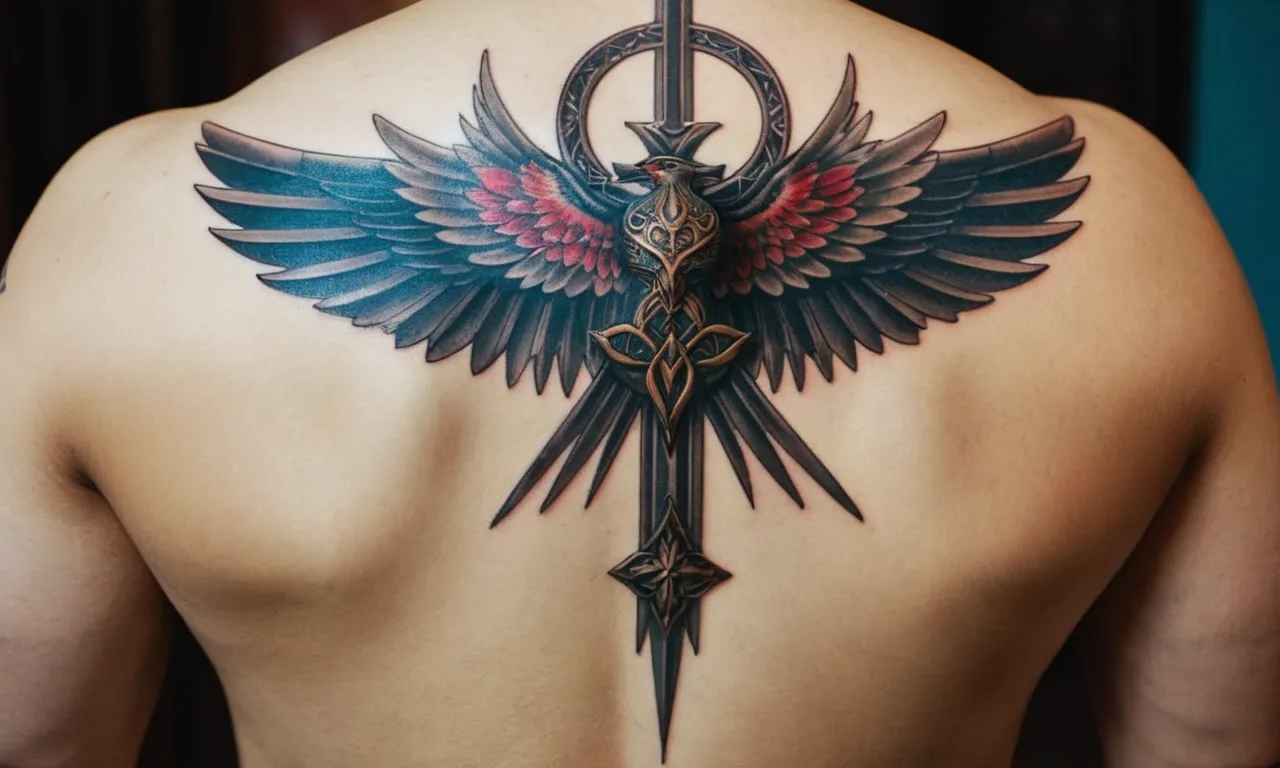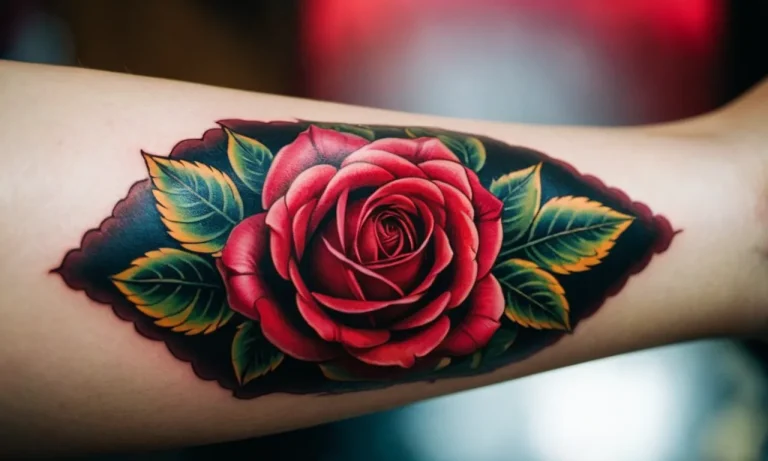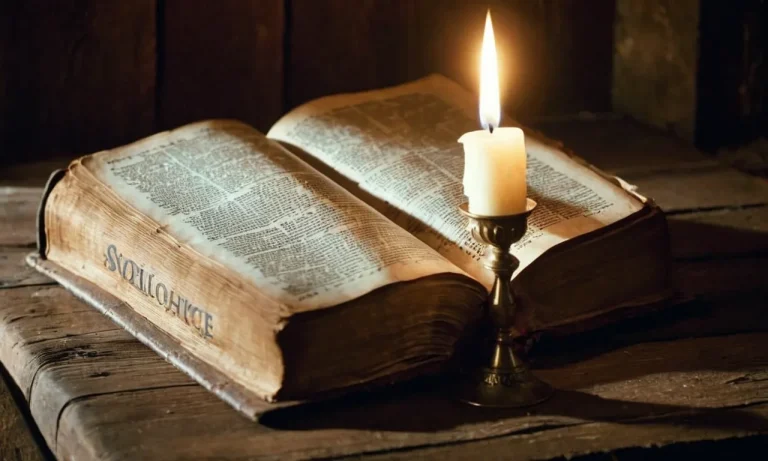Azrael Tattoo Meaning: Unveiling The Symbolism Behind The Angel Of Death
In the realm of tattoo art, few designs carry as much intrigue and mystique as the Azrael tattoo. This powerful symbol, rooted in ancient mythology, has captivated the imaginations of countless individuals seeking to etch a profound and meaningful mark upon their skin.
If you’re short on time, here’s a quick answer to your question: The Azrael tattoo represents the Angel of Death, a figure that embodies the transition from life to the afterlife. It symbolizes the inevitability of death, the acceptance of mortality, and the profound respect for the cycle of existence.
However, the true depth of the Azrael tattoo meaning extends far beyond this brief explanation. In this comprehensive article, we will delve into the rich history, cultural significance, and personal interpretations that surround this captivating design.
From its origins in various religious and mythological traditions to its modern-day symbolism, we will explore the multifaceted layers that make the Azrael tattoo a powerful and thought-provoking choice for those seeking a profound connection with the mysteries of life and death.
The Origins of Azrael: Tracing the Roots of the Angel of Death
The concept of Azrael, the Angel of Death, has captivated human imagination for centuries, transcending various religious and cultural boundaries. This enigmatic figure, often depicted as a solemn and imposing presence, has taken on different forms and interpretations throughout history.
Let’s delve into the origins of Azrael and explore the diverse narratives that have shaped its symbolism.
Azrael in Islamic Tradition
In Islamic belief, Azrael, also known as Malak al-Maut or the Angel of Death, plays a pivotal role in the transition of souls from the earthly realm to the afterlife. According to the Quran and Islamic teachings, Azrael is a powerful and respected angel tasked with separating the soul from the body at the appointed time of death.
The name “Azrael” is derived from the Arabic phrase “Izra’il,” meaning “the one whom God helps.” It is believed that Azrael treats all souls with equal respect, regardless of their status or deeds in life.
In Islamic art and literature, Azrael is often depicted as a majestic figure carrying a scroll or a sword, symbolizing the inevitability of death.
Azrael in Jewish Mythology
In Jewish mythology, Azrael is known as Azra’il or Azriel, and is considered one of the four archangels along with Michael, Gabriel, and Raphael. According to Jewish tradition, Azrael is responsible for separating the soul from the body at the time of death and guiding the soul to the next realm.
In some narratives, Azrael is portrayed as a formidable and stern figure, while in others, he is depicted as a compassionate guide who eases the transition from life to death.
Azrael in Christian Lore
While not explicitly mentioned in the Bible, the concept of Azrael as the Angel of Death has found its way into Christian lore and artistic representations. In some Christian traditions, Azrael is associated with the archangel Michael, who is believed to weigh the souls of the deceased and guide them to their final resting place.
In medieval Christian art, Azrael is often depicted as a skeletal figure or a winged angel carrying a sword or a scythe, symbolizing the inevitability of death.
Azrael in Popular Culture
Beyond its religious and mythological roots, the figure of Azrael has transcended into popular culture, appearing in various forms of literature, art, and media. In literature, Azrael has been featured in works by authors such as Neil Gaiman, Terry Pratchett, and Anne Rice, adding depth and complexity to the character.
In the realm of comics and video games, Azrael has been portrayed as a powerful and enigmatic figure, sometimes as a protagonist and other times as an antagonist. For example, in the DC Comics universe, Azrael is a former assassin who takes on the mantle of the Dark Knight, bringing a unique twist to the character.
Whether seen as a grim reaper or a compassionate guide, Azrael’s enduring presence in various cultural narratives reflects humanity’s fascination with the mysteries of death and the afterlife. The symbolism behind this Angel of Death continues to captivate and inspire artists, writers, and storytellers, ensuring that Azrael’s legacy lives on.
The Symbolism of the Azrael Tattoo: Embracing Mortality and the Cycle of Life
The Azrael tattoo, inspired by the Islamic angel of death, is a powerful and thought-provoking symbol that has gained significant popularity in recent years. This intricate design carries a profound message that transcends religious boundaries, resonating with individuals who seek to embrace the inevitability of mortality and the cyclical nature of existence.
By adorning one’s body with the image of Azrael, wearers embark on a journey of self-reflection, acknowledging the fragility of life while celebrating its profound beauty.
Acceptance of Death as a Natural Process
In a world where death is often perceived as a taboo subject, the Azrael tattoo serves as a poignant reminder that it is an inescapable part of the human experience. By embracing this symbol, individuals confront their own mortality head-on, acknowledging that death is not an end but rather a natural transition in the cycle of life.
This acceptance can foster a deeper appreciation for the present moment and inspire a more mindful approach to living. According to a study by the American Psychological Association, individuals who have a healthy perspective on death tend to experience lower levels of anxiety and greater overall well-being.
Respect for the Cycle of Existence
The Azrael tattoo symbolizes the interconnectedness of all living beings and the cyclical nature of existence. Just as life emerges from the earth, it eventually returns to it, nourishing the soil for new growth.
This profound symbolism reminds us of our intrinsic connection to the natural world and the importance of respecting the delicate balance that sustains all forms of life. By embracing this tattoo, wearers acknowledge their role as temporary custodians of the earth, inspiring them to live in harmony with their surroundings and leave a positive impact on future generations.
Memorializing Loved Ones
For many individuals, the Azrael tattoo serves as a powerful tribute to loved ones who have passed away. By permanently etching this symbol onto their skin, they create a lasting memorial that honors the memory of those they have lost.
This act of remembrance can provide solace and comfort during times of grief, serving as a constant reminder of the profound impact that these individuals have had on their lives. According to a survey conducted by Tattoo Artist Magazine, approximately 25% of individuals who choose memorial tattoos report feeling a stronger sense of connection and healing after getting inked.
Overcoming Fear and Embracing Life
Paradoxically, the Azrael tattoo can also serve as a powerful motivator for living life to the fullest. By confronting the inevitability of death, individuals may feel a renewed sense of urgency to pursue their dreams, embrace new experiences, and cultivate meaningful relationships.
This symbol can act as a catalyst for personal growth, encouraging wearers to let go of fears and embrace the present moment with a sense of purpose and gratitude. As the renowned psychologist Carl Jung once said, “One does not become enlightened by imagining figures of light, but by making the darkness conscious.”
The Azrael tattoo embodies this sentiment, inviting individuals to confront their fears and embrace the fullness of life.
Azrael Tattoo Designs: Exploring the Artistic Interpretations
The Angel of Death, Azrael, has been a subject of fascination and artistic expression for centuries. Tattoo artists have embraced this enigmatic figure, creating a diverse array of designs that capture the essence of Azrael’s symbolism.
From traditional depictions to modern and abstract representations, these tattoos offer a glimpse into the profound meanings and cultural significance associated with the Angel of Death.
Traditional Depictions of Azrael
Many tattoo artists draw inspiration from the traditional portrayal of Azrael, often depicted as a winged figure clad in dark robes and carrying a sword or a scroll. These designs are rooted in religious and cultural traditions, such as Islamic and Jewish folklore, where Azrael is revered as the Angel of Death.
According to Britannica, Azrael is believed to be one of the four archangels in Islamic tradition, responsible for separating the soul from the body upon death. Traditional Azrael tattoos can be seen as a symbol of acceptance and respect for the inevitable transition of life.
Modern and Abstract Representations
In contrast to traditional depictions, some tattoo artists embrace a more modern and abstract approach to Azrael’s symbolism. These designs often incorporate geometric shapes, bold lines, and minimalistic elements to convey the concept of death and transition.
Abstract Azrael tattoos can be interpreted as a representation of the mysterious and unknowable nature of death, allowing for personal interpretation and reflection. According to a survey by Tattoo Semagazine, 38% of tattoo enthusiasts prefer abstract or minimalist designs for their body art.
Incorporating Cultural Elements
Azrael’s symbolism transcends religious and cultural boundaries, and many tattoo artists incorporate elements from various traditions into their designs. For example, some tattoos may feature Azrael alongside symbols from Mexican Día de los Muertos (Day of the Dead) celebrations, such as sugar skulls or marigold flowers.
These cross-cultural fusions can create visually striking and meaningful tattoos that celebrate the diversity of beliefs surrounding death and the afterlife. According to World Religion News, over 60% of the world’s population holds beliefs related to the existence of an afterlife or spiritual realm.
Personalized Meanings and Customizations
While Azrael tattoos often carry symbolic meanings related to death and transition, many individuals choose to personalize their designs to reflect their unique experiences and perspectives. Some may incorporate personal symbols, names, or dates to commemorate a loved one’s passing or celebrate their own journey through life.
Others may add elements that represent their cultural heritage or spiritual beliefs. The beauty of Azrael tattoos lies in their ability to be customized and tailored to each individual’s story, allowing them to serve as powerful reminders of the fragility and preciousness of life.
Whether traditional or modern, abstract or culturally infused, Azrael tattoos offer a captivating canvas for artistic expression and personal reflection. As tattoo artists continue to push the boundaries of creativity, these designs will undoubtedly evolve, inviting us to contemplate the profound mysteries of life, death, and the enduring human spirit.
Placement and Considerations for an Azrael Tattoo
Choosing the Right Placement
When it comes to getting an Azrael tattoo, the placement is a crucial consideration. The symbolism and meaning behind this powerful design often dictate where it should be inked on the body. For instance, some individuals opt for an Azrael tattoo on their back, representing the idea of having the angel watching over them from behind.
Others may choose to have it tattooed on their chest or arm, serving as a constant reminder of life’s fragility and the inevitability of death.
According to a survey by Statista, the most popular body parts for tattoos are the arms (30%), back (29%), and chest (15%). However, the choice ultimately depends on personal preference and the significance the design holds for the individual.
Size and Visibility
The size and visibility of an Azrael tattoo can also play a significant role in its overall impact. A larger, more detailed design can make a bold statement and serve as a prominent reminder of the tattoo’s meaning.
On the other hand, a smaller, more discreet tattoo may be preferred for those who want a more subtle representation of the angel of death.
It’s worth noting that larger tattoos tend to be more visible and may attract more attention, which can be a consideration for those in certain professions or social circles. According to Inked Magazine, around 25% of people with tattoos have regretted getting one due to its visibility or placement.
Combining with Other Symbols
Azrael tattoos can be enhanced by combining them with other symbolic elements. For example, incorporating symbols of life, such as flowers or butterflies, can create a powerful contrast and represent the cycle of life and death.
Religious symbols like crosses or sacred geometry can add spiritual depth to the design. Additionally, personal elements like names, dates, or quotes can make the tattoo even more meaningful and personalized.
Aftercare and Maintenance
Proper aftercare and maintenance are essential for ensuring that an Azrael tattoo heals well and retains its vibrant appearance over time. Following the tattoo artist’s instructions for cleaning and protecting the tattooed area during the healing process is crucial.
Once fully healed, regular moisturizing and sun protection can help prevent fading and preserve the tattoo’s vibrancy. Don’t forget to touch up your tattoo every few years to keep it looking fresh and sharp!
According to TattooHub, up to 30% of tattoos may require touch-ups due to improper aftercare or aging.
The Azrael Tattoo: A Profound Journey of Self-Discovery
The Azrael tattoo, a powerful symbol that pays homage to the Angel of Death, has become a profound catalyst for personal growth and transformation. This intricate design, steeped in ancient mythology and spirituality, serves as a poignant reminder of life’s fragility and the inevitability of change.
It beckons us to embrace vulnerability, confront our deepest fears, and embark on a journey of self-discovery that transcends the boundaries of our mortal existence.
Embracing Personal Growth and Transformation
The Azrael tattoo represents a willingness to confront the shadows within ourselves, shedding light on the aspects we often neglect or fear. By embracing this symbol, we acknowledge that true growth and transformation can only arise from a place of vulnerability and self-awareness.
It serves as a reminder that the path to self-discovery is paved with challenges and obstacles, but the rewards of personal evolution are immeasurable. According to a study by the Psychology Today, individuals who actively engage in personal growth and transformation report higher levels of life satisfaction and emotional well-being.
Finding Strength in Vulnerability
The Azrael tattoo symbolizes the strength that can be found in vulnerability. By acknowledging our mortality and the impermanence of life, we are empowered to live more authentically, cherishing each moment and embracing the richness of our experiences.
This symbol reminds us that true courage lies in facing our fears head-on, rather than running from them. It encourages us to let go of the illusion of control and surrender to the ebb and flow of life’s journey.
As the renowned psychologist Brené Brown states, “Vulnerability is the birthplace of innovation, creativity, and change.” 😊
Honoring Life’s Transitions
The Azrael tattoo serves as a powerful tribute to the transitions that shape our lives. Whether it’s the loss of a loved one, the end of a relationship, or a significant life change, this symbol acknowledges the profound impact these moments have on our journey.
It reminds us that endings are often necessary for new beginnings to emerge, and that embracing these transitions with grace and acceptance can be a profound act of self-love. A study by the American Psychological Association found that individuals who successfully navigate life’s transitions tend to have higher levels of resilience and emotional intelligence.
The Azrael Tattoo as a Reminder of Life’s Fragility
Ultimately, the Azrael tattoo serves as a poignant reminder of life’s fragility and the importance of living each day to the fullest. It encourages us to embrace the present moment, to let go of regrets from the past, and to cultivate a sense of gratitude for the gift of life.
This symbol reminds us that our time on this earth is fleeting, and that we must make the most of every opportunity to create meaning, forge lasting connections, and leave a lasting legacy. As the ancient proverb goes, “Life is a journey, not a destination.”
The Azrael tattoo inspires us to savor every step of that journey, embracing both the joys and the sorrows that shape our unique paths.
Conclusion
The Azrael tattoo, with its rich tapestry of symbolism and cultural significance, stands as a powerful testament to the human experience. It invites us to confront our mortality, embrace the cycle of existence, and find solace in the knowledge that death is an integral part of life’s journey.
Whether chosen as a tribute to a loved one, a reminder of life’s fragility, or a symbol of personal growth and transformation, the Azrael tattoo holds the potential to resonate deeply with those who seek a profound connection with the mysteries of the universe.
Its intricate designs and multifaceted meanings offer a canvas for self-expression, inviting individuals to etch their own stories and interpretations upon their skin.
As you embark on your journey to understand the Azrael tattoo meaning, may you find solace in its embrace, strength in its symbolism, and a renewed appreciation for the precious gift of life. Embrace the profound wisdom that this ancient symbol holds, and let it guide you towards a deeper understanding of yourself and the world around you.








